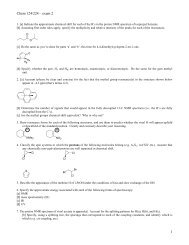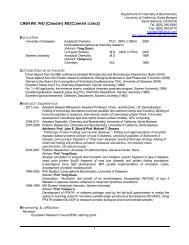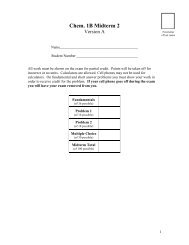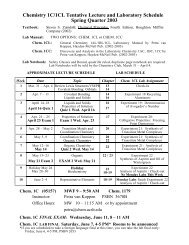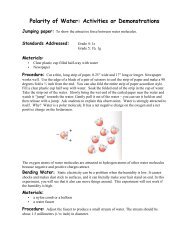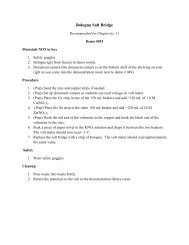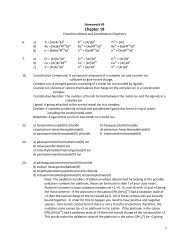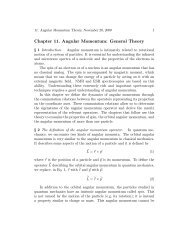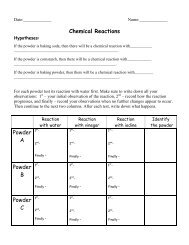Chapter 7. The Eigenvalue Problem
Chapter 7. The Eigenvalue Problem
Chapter 7. The Eigenvalue Problem
Create successful ePaper yourself
Turn your PDF publications into a flip-book with our unique Google optimized e-Paper software.
<strong>7.</strong> <strong>The</strong> <strong>Eigenvalue</strong> <strong>Problem</strong>, December 17, 2009 28<br />
<strong>The</strong> left-hand side of Eq. 147 can be written as (use p |e(p)e(p)| = Î)<br />
N<br />
p=1 k=1<br />
=<br />
N<br />
e(j) | Û −1 | e(p)e(p) | Ĥ | e(k)e(k) | Û | e(i)<br />
N<br />
p=1 k=1<br />
N U<br />
−1 H pk U ki = U −1 HU <br />
jp ji<br />
where we have denoted the matrix elements by<br />
<br />
U<br />
−1 jp ≡e(j) | Û −1 | e(p)<br />
(149)<br />
H pk ≡e(p) | Ĥ | e(k)<br />
U ki ≡e(k) | Û | e(i)<br />
and used the observation that the second double sum in Eq. 149 is the rule<br />
for matrix multiplication. This allows us to write the last term (i.e. U −1 HU)<br />
as the product of the matrices U −1 , H, andU. Combining Eq. 147 with<br />
Eq. 149 proves the theorem.<br />
We can go a step further and construct the matrix U from the eigenvectors<br />
of Ĥ. Wehavedefined Û through Eq. 145,<br />
Acting with e(j)| on this gives<br />
|x(i) = Û|e(i)<br />
e(j) | x(i) = e(j) | Û | e(i) = U ji (150)<br />
Using the completeness relation for the basis set {|e(i)} N i=1, wehave<br />
|x(i) =<br />
N<br />
|e(j)e(j) | x(i) (151)<br />
j=1<br />
This means that e(j) | x(i) are the components of the eigenket |x(i) in the<br />
basis {|e(i)} N i=1. <strong>The</strong>y are the numbers we obtain when we find the eigenvectors<br />
of the matrix H; the eigenvectors are x(i) ={e(1) | x(i), e(2) | x(i),<br />
..., e(N) | x(i) }. <strong>The</strong> matrix U is (see Eq. 150)<br />
⎛<br />
U =<br />
⎜<br />
⎝<br />
e(1) | x(1) e(1) | x(2) ··· e(1) | x(N)<br />
e(2) | x(1) e(2) | x(2) ··· e(2) | x(N)<br />
e(3) | x(1) e(3) | x(2) ··· e(3) | x(N)<br />
.<br />
.<br />
.. . .<br />
e(N) | x(1) e(N) | x(2) ··· e(N) | x(N)<br />
⎞<br />
⎟<br />
⎠<br />
(152)




